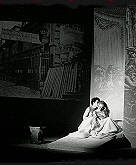


director writer
producer
Tom Palmer

On
Directing






SCRIPT ANALYSIS: Script is everything. The Alpha and the Omega. It's the blueprint for production, the road map to character, conflict and action. My work always begins with in-depth script analysis.
The work and influence of The Group Theatre in the 1930's and beyond forever changed the landscape of American Theatre. Over the years I've completely immersed myself in the writings and teachings of its Principals: Lee Strasberg, Stella Adler, Sanford Meisner and (as a director) Harold Clurman. It's the Clurman model of script analysis that I most frequently employ.
The notion of the "spine" of the play - the overriding thru-line action which runs as a unifying thread throughout each scene and each character's individual actions - is one I find both illuminating and practical. In preparing for rehearsal, I spend considerable time with each scene searching out that thread: breaking each scene into individual beats, developing a sense of tempo-rhythms, conflict-in-the-moment, actions of each character, and especially the 'event' of the scene. That analysis becomes my guidebook in rehearsal...
COLLABORATION: Over the years I've encountered two types of directors: those who believe their vision of the script is sacrosanct and who dictate virtually everything to cast and crew - from rigid blocking to specific, detailed line readings. Then there are those (and I count myself among them) who believe in the rehearsal hall as a place of collaboration; a place where individual contributors - director and designers, cast and crew - work together to shape the production. Certainly the director must take a strong lead, have a firm vision and function as the ultimate lens through which everything must pass. But a good idea doesn't care where it comes from. And in my experience, an open rehearsal hall in which ideas flow freely will almost inevitably lead to a stronger production.
That's especially true in my work with actors. I've been flattered over the years to have scores of actors refer to me as "an actor's director." That begins with the notion that in my rehearsal hall, there's no such thing as a "bad choice." I never want an actor to feel reluctant to try something new, something different, even something outrageous. Creativity simply cannot flourish if actors feel that by exploring a different interpretation, they open themselves to castigation or criticism from their director. Bottom line, I strive to create a rehearsal environment in which actors feel safe. That means not only that my actors have a sense of comfort and security in rehearsal. It means that through their creative exploration, they can often reveal to me something about the script I hadn't realized -- which in turn can change my view of a particular moment, a beat or sometimes an entire scene.
A Few Thoughts On Directing
CONFLICT & ACTION: Probably the most important lesson I've learned over the years is that acting is a verb... Its not about "attitude", well executed blocking, clever stage business or technique. It's about action. Character action. At the risk of sounding a bit pedantic: Character A wants something. Character B in some way stands as an obstacle to Character A achieving his objective. Therefore, we have conflict. And without conflict, there is no Play. It doesn't matter if we're talking about a Neil Simon comedy or a Jacobean Revenge Tragedy. No conflict...no Play.
It's within the framework of this conflict that actions arise. What action does Character A take to overcome the obstacle presented by Character B and achieve his objective? Does he attack? Deceive? Pursuade? Defend? Undermine? Blackmail? Shame? Seduce? What the action of choice will be is dependent on script, character traits, established character relationships, previous action, depth of motivation and more. But the lesson is clear. If an actor merely hits his mark onstage while reciting lines without doing something -- taking some kind of action to overcome obstacles and achieve his or her objective -- the audience soon will be taking a collective nap.
STAGING: My first directing mentor (Jack Welsh, retired Professor of Theatre Arts, University of Richmond) was fond of saying that, even if your audience is locked in a sound-proof booth, the majority of the action of the play should be apparent to all, based soley on what they see on the stage. Conversely, even the best acting performance can be undermined by inadequate staging.
In film, camera position, lens, editing are some of the director's tools used to tell the audience where to look, where to focus, what to see. In effect, the audience is presented with a "moving proscenium." Live Theatre, on the other hand, lives and breathes in a unique space, defined by the Theatre's physical plant, stage configuration, groundplan, set design and lighting. In this space, the director employs an entirely different set of tools. These include stage composition, picturization, balance, tension, sequence, stability. Taken together and used effectively, these tools help create the visual experience of a stage production. In one instance, the audience's eye is guided to the actor or actors the director wishes to emphasize. In another, the audience is rivited to a stage picture which communicates action more vividly than words. On balance, the rule is simple: The stage is an actor's medium, a medium of words and sound. But it is also a visual medium, a place of pictures and movement and choreographed action essential to telling the story and moving the audience. Both must be in play for a production to soar...